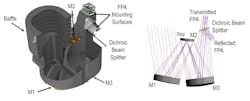
NASA has given the go-ahead to build a satellite to perform the first spectral survey of the whole sky. "We want to measure the spectrum of every pixel in the sky," says Jamie Bock, an experimental cosmologist at the California Institute of Technology (Pasadena, CA). The project will use a sophisticated algorithm to scan the sky with a novel off-axis spectroscopic telescope with no moving parts that will use continuously variable filters to record infrared spectra as the spacecraft scans the the sky.
The $242 million program is called SPHEREx, short for "Spectro-Photometer for the History of the Universe, Epoch of Reionization, and ices Explorer." That lengthy name summarizes the three main reasons astronomers want to record spectra from everything in the sky at wavelengths from 0.75 to 5 µm. Those infrared bands include red-shifted light that can provide crucial information on the ionization of hydrogen atoms by hot young stars, the history of galaxy formation, and the distribution of ices in the Milky Way.
SPHEREx will circle the Earth every 94.6 minutes in a sun-synchronous orbit at an altitude of 500 km. Reaction wheels will turn the spacecraft up to 70° to move the telescope to observe different parts of the sky for the survey. Once observations begin, the reaction wheels will turn the spacecraft in incremental steps to record spectra of that area before slewing to survey another part of the sky. The motions will be carefully programmed to record light intensity on all 96 spectral channels on every 6.2-arcsec "pixel" in the sky during a six-month period. The spacecraft's polar orbit allows it to spend extra time studying the north and south celestial poles so it can record fainter magnitudes than in the rest of the sky. Extra observing time also will go to surveying for ices in the galactic plane. The scanning pattern is complex, but it is so efficient that the spacecraft will spent 84.7% of its time on science observations.The optics are optimized for the survey. "To map the whole sky, you want a large throughput through the optical system," says Bock. With conventional optics, the spectrometer would be bigger than the telescope, but Bock's group found they could simplify the instrument by placing a continuously variable interference filter on top of each of the six focal-plane arrays (FPAs). That would spread a rainbow of infrared wavelengths across the detector so that each pixel would collect light in a different narrow slice of wavelengths.
Spectra will be recorded in a series of small steps. The reaction wheels first will point the instrument at one area, stay still for the detectors to collect light, then move a small step to shift the viewing angle slightly and shift each wavelength channel a step to the next row of pixels for the next observation. Baffles in SPHEREx exclude light from the Earth and Moon; the spacecraft is designed to avoid pointing the optics near the sun.
A spectral survey requires a wide field of view to cover the whole sky, and the telescope's three astigmatic aluminum mirrors and free-form surfaces give it a field of 11° by 3.5°. The telescope's effective diameter will be a relatively small 20 cm. Its optics will spread the collected light over the same type of 2000 by 2000-element mercury cadmium telluride (HgCdTe) focal plane arrays used on the James Webb Space Telescope. NASA also combined a small telescope with large field of view in its TESS exoplanet mission to survey stars in the solar neighborhood. Launched in April 2018, TESS has already spotted new exoplanets.
The telescope optics include beamsplitters and filters that divide input light into two sets of three bands. The three short-wavelength bands are delivered to HgCdTe FPAs sensitive to wavelengths as long as 2.5 µm. The three longer-wavelength bands are delivered to HgCdTe FPAs sensitive out to 5.3 µm. Separate continuously variable filters spread each band across the corresponding FPA, with chromatic dispersion splitting the input light into a total of 96 separate wavelength channels for spectral analysis based on which pixels in the FPA the dispersed light illuminated.
That design already worked successfully on the LEISA instrument on the New Horizons space probe, producing excellent spectral images of Jupiter and Pluto. SPHEREx takes the technology a level up in complexity because its mission is to survey the whole sky.
SPHEREx will use passive radiative cooling to keep its optics and 2.5-µm array at 80 K and its 5.3-µm array at 55 K. Plans call for four complete scans of the sky over two full years of operations. With no coolant or propellant to limit operation, Bock says SPHEREx can continue operation "as long as the reaction wheels keep going and we stay in orbit." Frictional drag will inevitably force NASA to de-orbit SPHEREx, but it should yield a wealth of spectroscopic information across the whole sky.
About the Author
Jeff Hecht
Contributing Editor
Jeff Hecht is a regular contributing editor to Laser Focus World and has been covering the laser industry for 35 years. A prolific book author, Jeff's published works include “Understanding Fiber Optics,” “Understanding Lasers,” “The Laser Guidebook,” and “Beam Weapons: The Next Arms Race.” He also has written books on the histories of lasers and fiber optics, including “City of Light: The Story of Fiber Optics,” and “Beam: The Race to Make the Laser.” Find out more at jeffhecht.com.

